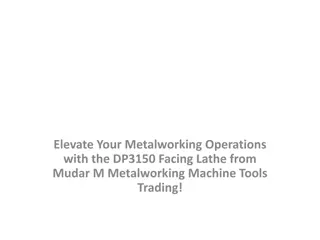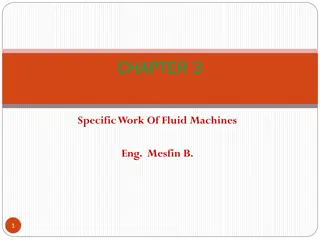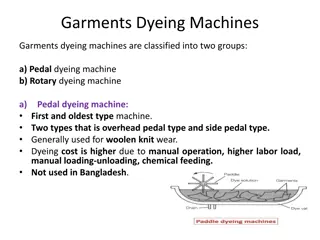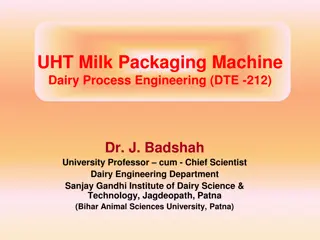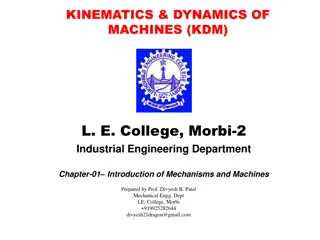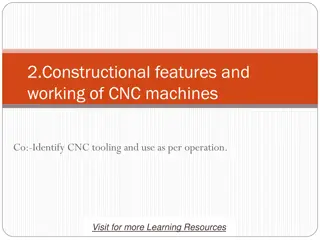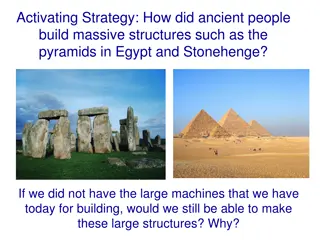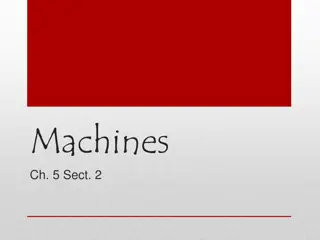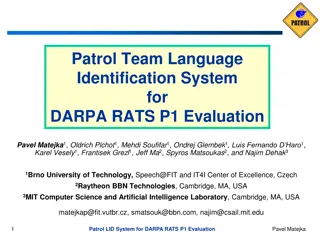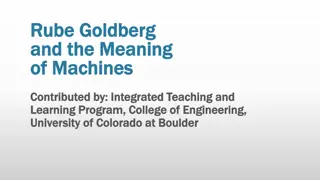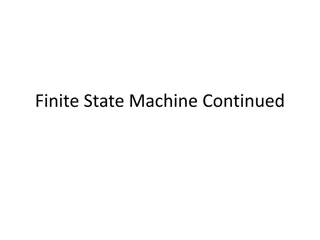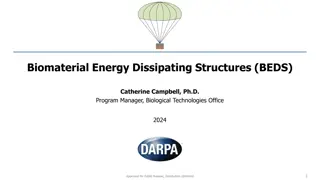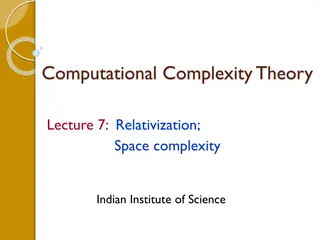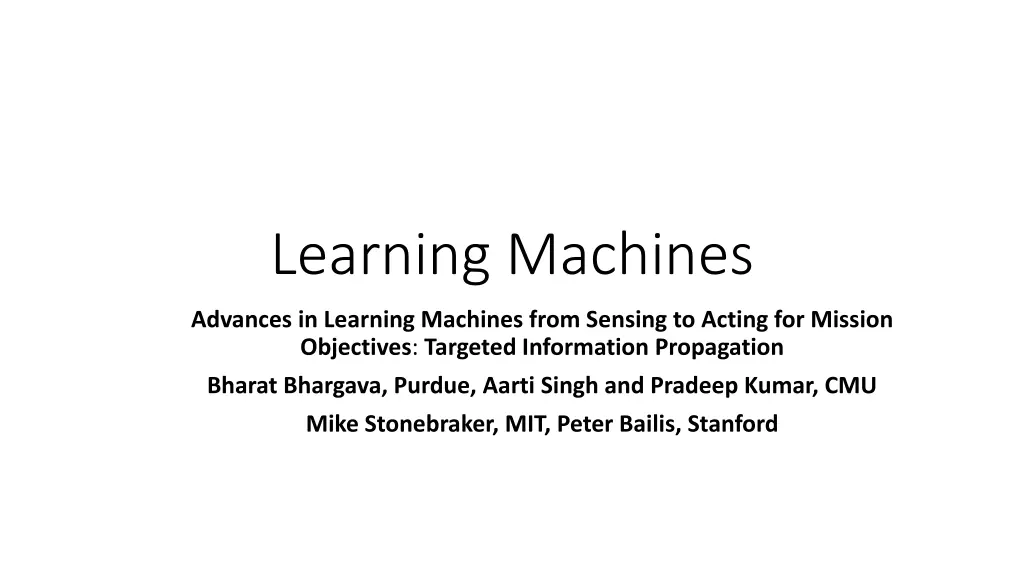
Advances in Learning Machines and Mission Objectives
Explore the cutting-edge developments in learning machines, targeted information propagation, and mission-relevant machine learning for efficient data management and information dissemination. Discover how scalable probabilistic models and robust algorithms are leveraged to extract and push relevant information securely to stakeholders in various sectors.
Download Presentation

Please find below an Image/Link to download the presentation.
The content on the website is provided AS IS for your information and personal use only. It may not be sold, licensed, or shared on other websites without obtaining consent from the author. If you encounter any issues during the download, it is possible that the publisher has removed the file from their server.
You are allowed to download the files provided on this website for personal or commercial use, subject to the condition that they are used lawfully. All files are the property of their respective owners.
The content on the website is provided AS IS for your information and personal use only. It may not be sold, licensed, or shared on other websites without obtaining consent from the author.
E N D
Presentation Transcript
Learning Machines Advances in Learning Machines from Sensing to Acting for Mission Objectives: Targeted Information Propagation Bharat Bhargava, Purdue, Aarti Singh and Pradeep Kumar, CMU Mike Stonebraker, MIT, Peter Bailis, Stanford
Team in University and Industry James MacDonald, Northrup Grumman Corporation, NG Fellow Data Analytics Jason Kobes, Northrup Grumman Corporation Professor Bharat Bhargava from Purdue University www.cs.purdue.edu/homes/bb Professor Michael Stonebraker (ACM Turing Award 2015, highest award in computer Science) MIT https://www.csail.mit.edu/person/michael- stonebraker#projects, https://en.wikipedia.org/wiki/Michael_Stonebraker Professor Pradeep Ravikumar at CMU, Machine Learning Department http://www.cs.cmu.edu/~pradeepr/ Professor Aarti Singh at CMU, Machine Learning Department: Label-efficient learning http://www.cs.cmu.edu/~aarti/ Professor Peter Bailis Stanford University. https://engineering.stanford.edu/people/peter-bailis
Mission-relevant machine learning and data management .
Objective Automatically extract data relevant to significant events, identify patterns related to a mission, and push relevant information efficiently with guarantees of end to end security to interested parties (e.g. analysts, cyber security experts, and decision makers). Identify patterns and push information to the relevant party with or without input from experts in a context-aware, timeliness manner. The data may be rich in information, fuzzy, known/unknown, so we reduce the clutter. The application will involve automatic labeling the data, predicting content to push to the right parties based on their profiles, preferences and context of interactions
Objective Scalable probabilistic graphical models for heterogeneous data will allow for scalable probabilistic reasoning: given values for some of the sensors, which are the likely analysts who would benefit from this information? Build robust learning algorithms that are robust both at training-time, to ward off data poisoning attacks that could be either malicious or inadvertent, or at test-time, to ward off adversarial inputs Preference learning algorithms that build models of analyst preferences (explicitly model possible cognitive biases, and correct for them)
Research Direction Active Learning by Deep Learning module in Cognitive Computing Engine uses session-based recommendation approach. User actions during the session are represented in a time-series dataset (sequential data), in which labels are not required, and are used as input to a Long-Short Term Memory (LSTM)-based model for training and prediction. User Model component builds profiles based on user s role, attributes, privacy policies, preferences, and behavior. The system SigMatch from CMU will be used to match mission demands with information available and authorized.Based on the user profile, Mission Requirements module decides the data from the Knowledge Discovery Engine that is propagated to the user. The context (e.g. normal vs. emergency) is used for targeting data propagated. Performance Monitor measures the following metrics: 1) timeliness, accuracy, and precision (TAP) of the propagated data; 2) system performance, including network bandwidth and other computer usage.
Research Directions Research Directions Perform data fusion from multiple heterogeneous data sources and prepare the data (collect, extract, translate, clean, adjust, preprocess, remove inconsistency, deal with missing data, format the data). Label-efficient learning: Machine learning methods for semi-supervised learning (a random subset of data is labeled), experimental design (a passively selected subset of data is labeled), transfer learning (labeled data from a related domain is used to minimize labels needed in target domain and active learning (a sequentially selected subset of data is labeled) will be utilized. Interactive learning: In addition to selecting which labels to obtain, active strategies can be used in unsupervised domains to decide what data and features to collect, store and process, as well as extended to incorporate more complex interactive feedback from humans/experts. Graph-structured learning: Methods for detection, localization, and recovery of weak patterns of activity observed by a sensor network such as graph scan statistics, graph wavelets and graph will be developed. The methods developed use random, adaptive and compressive measurements that leverage the graph structure to minimize measurement, computation, and storage budgets.
What we plan to Contribute Demonstration of scalability to large amount of data and information and efficient derivation of actable events for mission relevance and success. The modules for labeling, learning, mining, identifying patterns that perform in real-time. The prototype system will have innovative advances of learning machines for information propagation to target missions and satisfy the properties of timeliness, accuracy, precision, value. System operates in a secure and privacy preserving, trusted environment. Intelligent Autonomous systems will be advanced. Adverse Machine Learning ( poison in input training samples, untrusted data input)
Plans As a second step adaptable and intelligent learning machines are envisioned. We will develop foundations of hybrid learning machines methods to meet the mission objective. We will use analytics and gain knowledge including data relationships to drive enterprise actions according to mission demand. We will identify high priority decision needs and aggregate/analyze/visualize data. The contribution of learning machines to an application will be to transform large amount of data into relevant and timely knowledge affording the mission commander with a high level of trust, privacy and confidence

